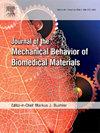Macroscopic creep behavior of spheroids derived from mesenchymal stem cells under compression
IF 3.3
2区 医学
Q2 ENGINEERING, BIOMEDICAL
Journal of the Mechanical Behavior of Biomedical Materials
Pub Date : 2024-11-13
DOI:10.1016/j.jmbbm.2024.106816
引用次数: 0
Abstract
Spheroid culture, where cells are aggregated three-dimensionally, is expected to have applications as a model that better recapitulates in vivo environment beyond two-dimensional environments. When human mesenchymal stem cells are subjected to spheroid culture in the presence of osteogenesis supplements, the gene expression of osteocyte differentiation marker is greatly increased within a short period compared to two-dimensional culture. However, how such alterations may be reflected to mechanical properties of the spheroid remains unknown. In this study, using a uniaxial compression system, we evaluated the macroscopic mechanical properties of human mesenchymal stem cell-derived spheroids including viscoelastic behavior. The Young's modulus of spheroids cultured for 2 days was about 18 kPa, whereas that of individual cells is around 1–10 kPa. We also found that creep behavior of the spheroid was greater in 50% strain compression beyond 10 or 30% strain, indicating that they are viscoelastic materials. Upon release from compression, the spheroids tended to revert to their original shape through elastic deformation. However, spheroids in which actin filament formation was inhibited exhibited a remarkably greater plastic deformation, suggesting that the actin filaments play a crucial role in the elastic behavior of spheroids. By understanding the mechanical properties and behavior of spheroids, it provides a framework for predicting and manipulating the development of tissues and organs in the field of morphogenesis.
间充质干细胞球体在压缩条件下的宏观蠕变行为。
球形培养是将细胞进行三维聚集的培养方式,作为一种能更好地再现二维环境之外的体内环境的模型,其应用前景被寄予厚望。当人类间充质干细胞在成骨补充剂存在下进行球形培养时,与二维培养相比,成骨细胞分化标记的基因表达在短时间内大大增加。然而,这种变化如何反映到球形体的机械性能上仍是未知数。在本研究中,我们使用单轴压缩系统评估了人间质干细胞衍生球体的宏观机械性能,包括粘弹性行为。培养 2 天的球体的杨氏模量约为 18 kPa,而单个细胞的杨氏模量约为 1-10 kPa。我们还发现,在 50%应变的压缩过程中,球体的蠕变行为大于 10%或 30%应变,这表明它们是粘弹性材料。从压缩中释放出来后,球体往往会通过弹性变形恢复到原来的形状。然而,抑制肌动蛋白丝形成的球体表现出明显更大的塑性变形,这表明肌动蛋白丝在球体的弹性行为中起着至关重要的作用。通过了解球体的机械特性和行为,它为预测和操纵形态发生领域中组织和器官的发育提供了一个框架。
本文章由计算机程序翻译,如有差异,请以英文原文为准。
求助全文
约1分钟内获得全文
求助全文
来源期刊

Journal of the Mechanical Behavior of Biomedical Materials
工程技术-材料科学:生物材料
CiteScore
7.20
自引率
7.70%
发文量
505
审稿时长
46 days
期刊介绍:
The Journal of the Mechanical Behavior of Biomedical Materials is concerned with the mechanical deformation, damage and failure under applied forces, of biological material (at the tissue, cellular and molecular levels) and of biomaterials, i.e. those materials which are designed to mimic or replace biological materials.
The primary focus of the journal is the synthesis of materials science, biology, and medical and dental science. Reports of fundamental scientific investigations are welcome, as are articles concerned with the practical application of materials in medical devices. Both experimental and theoretical work is of interest; theoretical papers will normally include comparison of predictions with experimental data, though we recognize that this may not always be appropriate. The journal also publishes technical notes concerned with emerging experimental or theoretical techniques, letters to the editor and, by invitation, review articles and papers describing existing techniques for the benefit of an interdisciplinary readership.
 求助内容:
求助内容: 应助结果提醒方式:
应助结果提醒方式:


